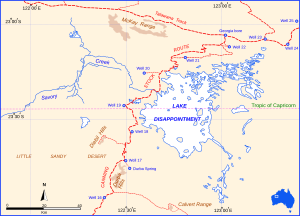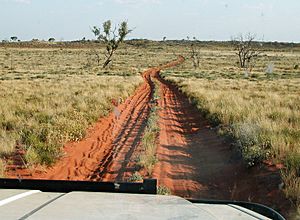Little Sandy Desert facts for kids
Quick facts for kids Little Sandy Desert |
|
|---|---|

The map shows Australia's bioregions. The Little Sandy Desert is the area in red.
|
|
| Area | 111,500 km2 (43,100 sq mi) |
| Geography | |
| State | Western Australia |
| Region | Australia |
The Little Sandy Desert is a large desert in the state of Western Australia. It is located to the east of the Pilbara region and is part of a huge area of deserts in the middle of the Australian continent.
For thousands of years, this land has been home to Indigenous Australians. The Australian government also recognizes it as a special environmental area called a bioregion.
Contents
A Land with a Long History
The first people to live in this region were Aboriginal Australians, including a group called the Mandilara. Today, the Martu people are recognized as the traditional owners of the land. This means they have a deep, historical connection to this place and are responsible for caring for it.
A famous historic trail called the Canning Stock Route crosses the desert. It was created in the early 1900s to move cattle across the country.
What the Desert Looks Like
The Little Sandy Desert is huge, covering about 111,500 square kilometers. It sits next to two other big deserts: the Great Sandy Desert to the north and the Gibson Desert to the east.
The landscape is mostly made of rolling red sand dunes, rocky hills called mesas, and flat, stony plains. The weather is extreme, with very hot summers and very little rain. The desert gets about 178 mm of rain in an average year, which is not very much.
The Rudall River starts in the Little Sandy Desert. It flows northeast and sometimes fills up Lake Dora, which is a salt lake that is often dry. There are a few natural springs in the hills that have water all year round.
A small town called Jigalong is on the western edge of the desert. About 300 people lived there in 2016. There are also two smaller communities in the desert, called Parnngurr and Punmu.
Important Places in the Desert

Here are some of the key landmarks and ranges found in the Little Sandy Desert:
- Carnarvon Range (also known as Katjarra)
- Calvert Range
- McKay Range
- Durba Hills
- Savory Creek
- Kumpupintil Lake (a large salt lake)
- The start of the Rudall River
Plants and Animals of the Desert
The Little Sandy Desert is full of life. It has a high level of biodiversity, which means there is a wide variety of different plants and animals.
Most of the land is covered in spiky hummock grass. You can also find trees like eucalypts, acacias, and bloodwoods growing on the sand hills. The local Martu people have traditionally used plants for many things. For example, they use the bark of the birdflower plant to make belts and sandals. They use the wood of the spear tree to make spears for hunting and digging sticks for finding food.
Many types of reptiles and birds live here. Over 116 bird species have been seen in the desert, including the large Australian bustard and the bush stone-curlew.
Threats to Wildlife
Sadly, many of the desert's native animals are threatened. Some small and medium-sized mammals have even disappeared from the area.
Threatened animals include:
- The Greater bilby, a rabbit-like marsupial with long ears.
- The Princess parrot, a colorful bird.
- The Kakarratul, also known as the northern marsupial mole, a blind creature that "swims" through the sand.
- The Brush-tailed mulgara, a small, carnivorous marsupial.
- The Grey falcon, a rare bird of prey.
The wildlife faces several dangers. Big wildfires, often made worse by climate change, can damage the habitat. Non-native animals, also called feral animals, cause big problems. Feral camels can damage water sources, while feral cats and foxes hunt native animals like bilbies and mulgaras. An invasive plant called Buffel grass is also spreading, pushing out native plants.
Katjarra: A Sacred Place
The Carnarvon Range, called Katjarra by the Martu people, is a very important place. It is a sacred site connected to stories of a creator being known as the rainbow serpent.
Katjarra is famous for its ancient rock art. The rock walls are covered in paintings of animals like the bilby and the black-flanked rock-wallaby. These paintings were made with natural pigments like ochre and charcoal. It is one of the biggest rock art sites in Australia.
Karnatukul: A Window to the Past
A site within Katjarra, now called Karnatukul, has an amazing history. For a long time, scientists thought people had lived there for 25,000 years. But a study in 2018 found proof that humans have been visiting the site for about 47,830 years!
This makes it the oldest known place where people have lived continuously in the entire Western Desert region. People gathered here even during the last ice age, when the desert was even drier and colder. The discovery helps us understand how people survived in such a harsh environment for so long.
To protect this special place, the Martu traditional owners closed Katjarra to visitors in 2008. They are now working to protect the art and artifacts. They have started to allow a small number of visitors in for short periods, with special permits, so people can learn about its amazing history and culture.
Interesting facts about the Little Sandy Desert
- The Little Sandy Desert covers around 110,900 km2 (42,800 sq mi).
- It was declared an interim Australian bioregion in the 1990s.
- The Little Sandy Desert is a harsh and remote environment. There are very few roads or tourist facilities. Only experienced travelers who are prepared to survive on their own should try to visit.
- The main economic activities in the region are mining for copper and gold.
See also
 In Spanish: Pequeño Desierto Arenoso para niños
In Spanish: Pequeño Desierto Arenoso para niños
- Deserts of Australia
- List of deserts by area



